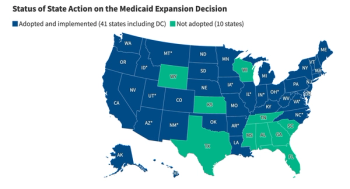
Healthcare Spending Growth Slips Back Into Normal Range in 2021: CMS Actuaries
Spending growth sank from 9.7% in 2020 to 4.2% in 2021 as special pandemic-related programs tapered off, according to CMS actuaries. But in article published in Health Affairs they project spending growth to continue at a steady clip this decade with the country’s total spending on healthcare project to reach $6.751.5 trillion by 2030.
CMS actuaries say national spending on healthcare slipped back to normal levels in 2021 as funds from the special programs, such as Provider Relief Fund, to prop up the sector in 2020 tapered off. At the same, the actuaries say spending by conventional payers — private insurers, Medicare and Medicaid — jumped in 2021 as the result of a rebound in patient care. The end result is national healthcare spending growth of 4.2% in 2021, a 5.5 percentage drop from the 9.7% increase in 2020.
The actuaries project that spending growth will gradually increase to 4.6% in 2022, 5.0% in 2023, and $5.1% in 2024. By 2030, they project that that national healthcare expenditures will reach $6.75 trillion dollars and be 19.6% of the gross domestic product (GDP)
The spending figures are scheduled for publication in the April 2022 issue of Health Affairs but were made available today.
The CMS actuaries say health spending in 2021 was $4.12 trillion and accounted for 18.8% of GDP).
According to their calculations, spending growth by private insurers in 2021 is expected to be 6.3% in 2021 and 8.3% this year in contrast with a -1.2% decrease in spending in 2020 as people with private insurance stopped using healthcare services because of the pandemic.
Similarly, growth in Medicare spending in 2021 is expected to be 11.3% and 7.5% this year as use of services rebounds after dipping to just 3.5% in 2020 during the height of the pandemic.
Medicaid spending is a different story because enrollment in the program has skyrocketed during the pandemic. The spending growth in 2021 is expected to be 10.4% in 2021, a modest increase from the 9.2% spending growth figure in 2020. But spending growth in 2020 was a 6.2-percentage point leap from the 3.0% spending growth in the 2019.
In 2021, health insurance was the source of 71% of healthcare funds ($3.064 trillion out of $4.297 trillion).
Newsletter
Get the latest industry news, event updates, and more from Managed healthcare Executive.






















































